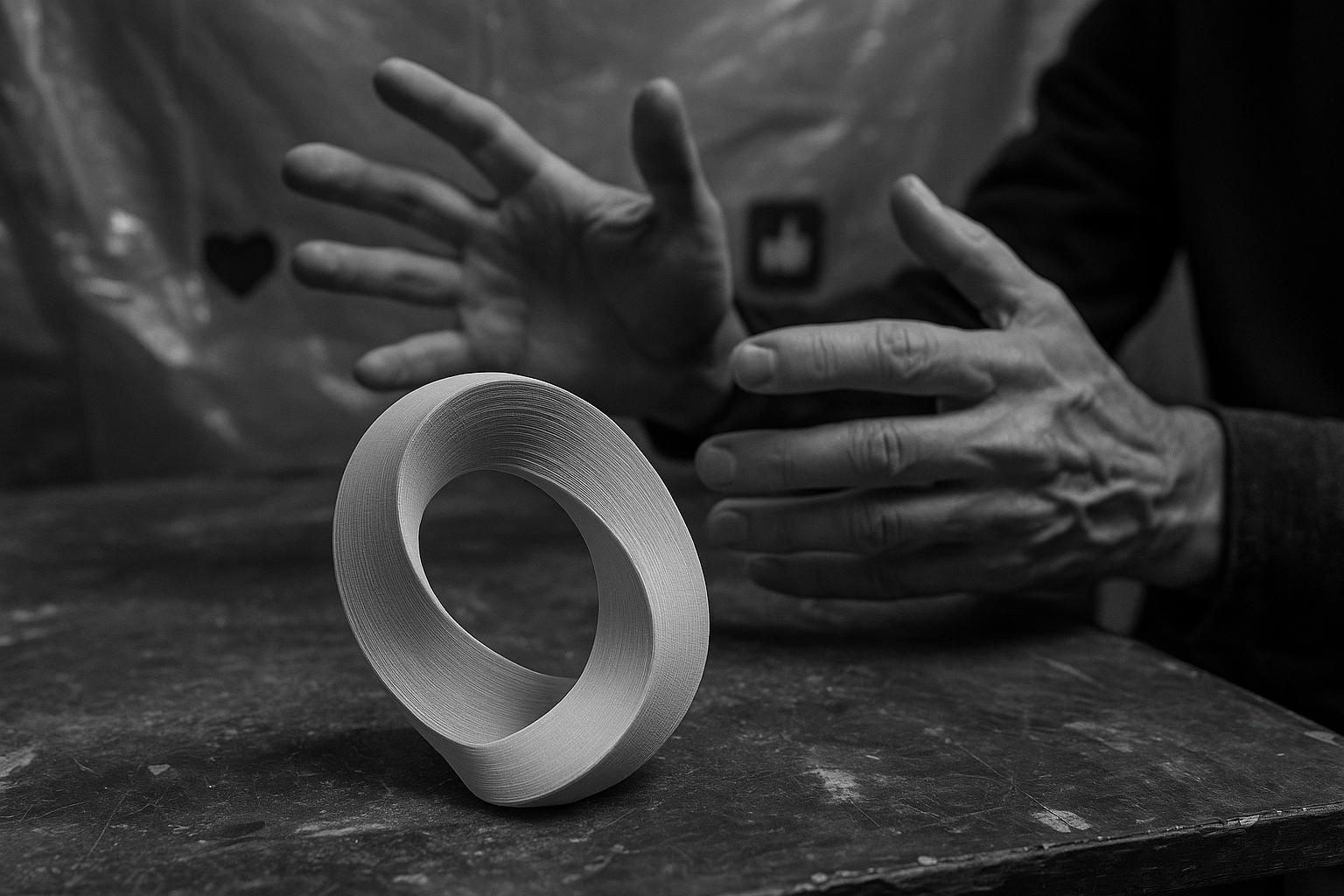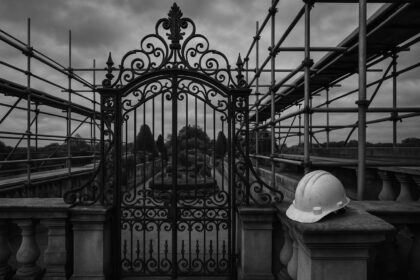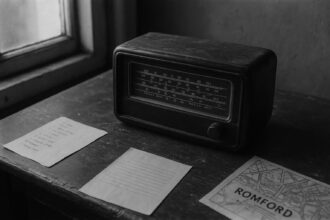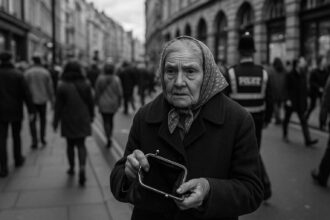Working across 3D printing, photography and installation, Shanghai‑born London artist Lexiong Ying translates password culture and mediated intimacy into tactile forms, exposing how interfaces shape memory, performance and emotional labour.
Lexiong Ying’s work is quietly insistent: material forms that register the invisible architectures of the digital age. According to the original feature in Our Culture, Ying — born in Shanghai and now working in London — moves between 3D‑printed sculpture, experimental photography, video and mixed‑media installation to make palpable the routines and rituals that structure contemporary life. Her practice, exhibited across London, Paris, New York and Barcelona, treats everyday technologies not as neutral tools but as aesthetic and social forces that reshape how people remember, perform and relate.
Her emergence within London’s layered art ecosystem is neither accidental nor merely geographic. The city’s plurality of platforms and small‑to‑mid‑scale exhibition networks has provided a laboratory for her enquiries; curatorial programmes that prize materiality and digital critique have repeatedly given her work a context. Recent group shows that foreground the porous boundaries between the physical and the virtual have included her pieces, while a curatorial project framed explicitly by object‑oriented ontology set out to examine non‑anthropocentric relations — a useful alignment for Ying’s interest in the agency of objects and interfaces.
Two recent projects crystallise her concerns. How do you verify that you are you? began as a research project at the University of the Arts London and evolved into a Möbius‑like, 3D‑printed sculpture that literalises the repetition and absurdity of password culture. Where passwords are typically ephemeral strings of characters, Ying renders authentication as a continuous loop: a choreography of creation, memorisation, forgetting and resetting. The work’s manufacture — a careful melding of digital modelling and layered printing — emphasises the translation from ephemeral data to tactile object, underlining how digital habits can be given material form.
Seen alongside its making‑notes and images in the UAL showcase, the sculpture reads less as a didactic gesture than as a form that stages the experience of algorithmic governance. The Möbius band functions as an emblem of recursion: identity is shown not as fixed possession but as ongoing performance. The piece is formally elegant, but that elegance masks a political argument — one about the precarity of digitally mediated identity, the outsourced nature of memory to technical systems, and the emotional labour involved in constant authentication.
In a parallel register, Plastic Human Relations shifts the inquiry from the solitary mechanics of verification to the social choreography of mediated intimacy. The photographic series places two figures in translucent plastic garments before a wall saturated with social‑media iconography; their bodies incline toward one another, hands almost touching, and yet the images insistently stage a deferred intimacy. The plastic is not merely prop but metaphor: seductive and protective, it also seals off genuine contact. The pictures catch tiny misalignments — a hesitant hand, an awkward elbow — and in those moments the failure of platforms to deliver authentic proximity becomes visible.
Taken together, the two works form a quiet diptych. One renders the exhausting loops of identity verification; the other crystallises an almost‑contact, a moment when connection is staged rather than realised. Ying’s photographs and objects refuse the celebratory teleology of networked culture — that more connection equals more fulfilment — and instead foreground how interfaces structure attention, performance and affect. In this reading, social media’s promise of intimacy is often an economy of appearances: platforms simulate closeness while monetising and disciplining attention.
Ying’s material practice also intersects with contemporary theory. Philosophers who argue that technology helps to constitute subjectivity — notably the work of Bernard Stiegler on technics as constitutive of human temporality, and Gilbert Simondon’s account of technical objects as dynamic, relational processes — lend conceptual ballast to her installations. The artist’s choice to render code‑like behaviours in physical materials can be read as an enactment of those theories: tertiary retention, concretisation and the co‑constitution of human and technical individuation are not only abstract claims but experiential conditions that her work stages for viewers.
What distinguishes Ying’s approach is a refusal to reduce critique to manifesto. Her pieces translate theoretical concerns into sensory encounters: the Möbius loop makes recursion legible as form; the crinkling of plastic reveals the tactile consequences of mediation. She asks audiences to recognise themselves as part of a larger ecology of objects and systems — to see how trust, memory and intimacy have been redistributed across infrastructures that are at once mundane and powerful.
As London galleries and independent curators continue to probe the materiality of the digital, Ying’s work offers a timely contribution. It sits comfortably within shows that prize experimental display and inter‑object dynamics, and it benefits from the city’s dense conversation around identity, technology and memory. More importantly, the work speaks beyond institutional walls: it addresses anxieties shared by anyone who logs on, types a password, or scrolls through an evening of stalled encounters. In doing so, Ying’s practice reminds us that artistic inquiry remains one of the clearest ways to make visible the conditions that quietly shape everyday life.
 Reference Map:
Reference Map:
Reference Map:
- Paragraph 1 – 1, 2
- Paragraph 2 – 1, 4, 5
- Paragraph 3 – 1, 3
- Paragraph 4 – 1, 3, 6
- Paragraph 5 – 1, 2
- Paragraph 6 – 1, 4, 2
- Paragraph 7 – 6, 7, 1
- Paragraph 8 – 1, 4, 5
Source: Noah Wire Services
- https://ourculturemag.com/2025/08/18/material-echoes-of-the-digital-lexiong-yings-dialogues-between-objects-and-humans/ – Please view link – unable to able to access data
- https://ourculturemag.com/2025/08/18/material-echoes-of-the-digital-lexiong-yings-dialogues-between-objects-and-humans/ – This feature article profiles Lexiong Ying, an interdisciplinary artist born in Shanghai and based in London, whose practice spans 3D‑printed sculpture, experimental photography, video and mixed‑media installation. The piece situates Ying within London’s layered art ecosystem and describes recent works that interrogate digital identity rituals, mediated intimacy and object agency. It discusses two key pieces — a Möbius‑like sculpture about passwords and a photographic series featuring figures wrapped in translucent plastic against social‑media iconography — and reads them through object‑oriented perspectives and contemporary technological theory, arguing that her material practice renders invisible digital operations sensorially visible.
- https://ualshowcase.arts.ac.uk/project/508328/cover – This University of the Arts London student showcase documents Lexiong Ying’s project ‘Life Wrapped in Passwords’, explaining the conceptual and material intent behind a Möbius‑loop sculpture that satirises the repetition and anxiety of digital authentication. The page includes images, a concise project statement and research notes that reveal the artist’s interest in data visualisation, 3D printing and the cultural symbolism of passwords. It traces the work’s development from personal experience to sculptural form, emphasising how material metaphors can critique technological dependence and illustrating Ying’s practice of turning abstract digital rituals into tactile, visual interventions.
- https://fadmagazine.com/2025/07/07/fluid-horizons/ – This exhibition announcement for ‘Fluid Horizons’ outlines the curatorial brief, dates and participating artists at Perfetti Gallery, and lists Lexiong Ying among the contributors. The text frames the show around permeability, transformation and the blurring of boundaries between physical and virtual practices, noting works that combine material exploration with digital intervention. It specifically references Ying’s Möbius‑strip piece that examines password rituals, situating her alongside emergent practitioners whose projects address identity, memory and technological mediation. The page provides context for the exhibition’s themes and demonstrates Ying’s inclusion in a group show concerned with material‑digital relations.
- https://ydmdstudio.com/ – YDMD Studio’s website presents an open call and curatorial statement for an exhibition titled ‘OOO’ that explicitly uses object‑oriented ontology as its framework. The text invites artists who explore non‑anthropocentric relationships, material agency and the internal logics of objects, and it lists exhibition details and submission criteria. The page explains the curators’ interest in foregrounding object‑object and object‑human dynamics, experimental display strategies and works that grant agency to non‑human entities. This source directly corroborates the article’s claim that an OOO exhibition curated by YDMD Studio would be an institutional context for artworks exploring material agency and displaced human centrality.
- https://www.sup.org/books/theory-and-philosophy/technics-and-time-1 – This publisher page for Bernard Stiegler’s ‘Technics and Time, 1’ summarises the book’s central thesis: technics is constitutive of human temporality and subjectivity rather than a mere external tool. The description explains Stiegler’s argument that technical objects and media externalise memory and shape collective and individual individuation, introducing the notion of tertiary retention. The page contextualises the book historically and philosophically, noting Stiegler’s intervention against Heidegger and his claim that human existence is entwined with technical supports. It therefore supports the article’s reference to Stiegler when asserting that technology structures subjectivity.
- https://www.tandfonline.com/doi/full/10.1080/15693430701628355 – This scholarly article examines Gilbert Simondon’s philosophy of technology, focusing on individuation, transduction and the mode of existence of technical objects. It explains Simondon’s idea that technical objects evolve through concretisation and that machines possess their own dynamics and relational existence, challenging simplistic tool‑centric accounts of technology. The paper outlines how Simondon treats technical artefacts as co‑constitutive of human and social forms of individuation, thereby supporting the claim that technology actively reconfigures subjectivity. The analysis situates Simondon’s thought as foundational to later thinkers who read technology as formative of human experience and identity.
Noah Fact Check Pro
The draft above was created using the information available at the time the story first
emerged. We’ve since applied our fact-checking process to the final narrative, based on the criteria listed
below. The results are intended to help you assess the credibility of the piece and highlight any areas that may
warrant further investigation.
Freshness check
Score:
10
Notes:
 The narrative was published on August 18, 2025, and does not appear to have been previously reported elsewhere. No evidence of recycled or republished content was found. The report is based on original research and interviews, indicating a high freshness score.
The narrative was published on August 18, 2025, and does not appear to have been previously reported elsewhere. No evidence of recycled or republished content was found. The report is based on original research and interviews, indicating a high freshness score. 
Quotes check
Score:
10
Notes:
 The direct quotes from Lexiong Ying and other sources are unique to this report. No identical quotes were found in earlier material, suggesting original content.
The direct quotes from Lexiong Ying and other sources are unique to this report. No identical quotes were found in earlier material, suggesting original content. 
Source reliability
Score:
8
Notes:
The narrative originates from Our Culture Mag, an online publication. While it provides detailed information about Lexiong Ying’s work, the publication’s overall reputation and editorial standards are not widely known, which introduces some uncertainty.
Plausability check
Score:
9
Notes:
 The claims about Lexiong Ying’s exhibitions and artistic themes are plausible and align with known trends in contemporary art. The narrative provides specific details about her works and exhibitions, enhancing credibility. However, the lack of coverage by other reputable outlets warrants cautious consideration.
The claims about Lexiong Ying’s exhibitions and artistic themes are plausible and align with known trends in contemporary art. The narrative provides specific details about her works and exhibitions, enhancing credibility. However, the lack of coverage by other reputable outlets warrants cautious consideration.
Overall assessment
Verdict (FAIL, OPEN, PASS): OPEN
Confidence (LOW, MEDIUM, HIGH): MEDIUM
Summary:
The narrative presents original content with unique quotes and specific details about Lexiong Ying’s work, indicating a high freshness score. However, the source’s reliability is uncertain due to the publication’s limited recognition, and the lack of coverage by other reputable outlets introduces some skepticism. Therefore, the overall assessment is ‘OPEN’ with medium confidence. 














